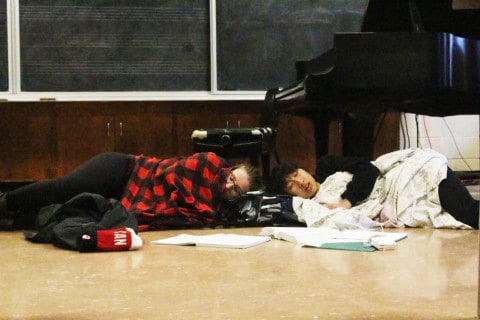With the relentless burden of deadlines, midterms and finals, stress has become normalized as a day-to-day reality for students. Although the University of Saskatchewan currently provides many stress-relief measures, none of these can substitute for a good old-fashioned nap.
Experts recommend around eight hours of sleep per night, although it is inevitable that many students fall short of this requirement. This leads to sleep deprivation which can be characterized by symptoms such as  fatigue, stress and a reduced capacity for learning, memorization and retaining information.
fatigue, stress and a reduced capacity for learning, memorization and retaining information.
According to the Spring 2013 National College Health Assessment II survey, 93 per cent of U of S students reported that they felt tired throughout the day at least once a week, while 25 per cent reported that sleep-associated problems negatively impacted their performance in school. Given the substantial number of students affected by sleep deprivation, this is an issue that the university should assist in tackling.
The U of S currently provides services to help reduce stress levels among students, offering recreational classes such as yoga and meditation, access to therapy dogs throughout the semester and library stations such as Play-Doh and cookie decorating during finals.
Although these measures are effective mechanisms to assist in certain areas of stress-reduction, nothing can compensate for sleep. To complete the availability of stress-reducing services to students, I argue that we reserve a space on campus for the sole purpose of napping.
A vicious cycle emerges from sleep inadequacy — you stay up late because you need to study, but when you aren’t getting enough sleep, studying is increasingly more difficult. Not only does it require more energy to concentrate when you’re tired, but you’re tiring yourself out even more when your body is low on sleep.
Many students resort to quick-fixes to bridge the gap of awakeness and concentration while sacrificing a lengthy sleep in order to buy more time. Caffeinated beverages and performance-enhancing substances are often consumed in large quantities to compensate for sleep.
Such habits have detrimental and adverse effects on students’ health, both mentally and physically. However, it is inevitable that students will use such measures, including neglecting one’s health, to get by academically.
Many of us find ourselves starting to — or already — dozing off in class, or we have long breaks between classes that could be made useful with a nap. When it comes to midterms and finals season, many of us spend late nights on campus that seem almost unmanageable without a quick snooze.
For individuals to be at the peak of learning and attentiveness in both the classroom and study sessions, experts recommend a 10–20 minute power nap. A power nap is early enough within the stages of non-rapid eye movement sleep to increase mental cognition and physical energy without causing you to wake up feeling groggy.
Although a power nap won’t compensate for a full eight hours of sleep, it may provide the extra push students need to increase productivity — it’s a healthier alternative to let your brain and body regenerate and unwind rather than consuming copious amounts of caffeine to get by.
Napping rooms are not such a far-fetched idea. Already, the University of Calgary and Mount Royal University have taken initiative to implement such a measure. Although some bathrooms in different locations on campus have unofficial napping stalls within them — such as the women’s bathrooms in the Education and Arts Buildings — many of these mattresses have since been removed.
Much like a balanced diet and exercise, sleep is crucial for students to maintain a healthy lifestyle. The university provides many services in different health-related areas of care and I suggest that to increase the academic performance and well-being of its students, the U of S should take steps to designate a room and provide the means for napping.